No dog is as easy to recognize nor as controversial as Pug. Everyone has an opinion on these small brachycephalic dogs that have quickly become one of the most sought-after family pets you can find.
While most people think that Pugs are a fairly new dog breed, this is, in fact, one of the most ancient canines there. The first data about Pugs originates from 400 years B.C., at the time when these dogs were kept as family companions for wealthy people.
In fact, many other flat-faced, wrinkly dogs come from Chinese breeders, such as the Shih Tzu, The Pekingese, as well as the Lo-Sze, which is known as the Pug’s ancestor.
Somewhere around 200 B. C., the Emperor Chin Shih Huang ordered all records of Pugs to be deleted, as he considered them a sacred breed that had to be hidden. This is why the details regarding the origin of this dog breed remained a mystery.
Still, this didn’t stop people from talking about the Pug breed and its unique appearance and characteristics.
Over time, these dogs were brought to Russia, Japan, and then to the U.S., as well. Their big, round eyes and flat face, as well as numerous Pug colors they come into, made them a common household name.
Speaking of Pug colors, while the Pugs come in two accepted coat colors, did you know that they can come in several other shades? While not as colorful as some other dog breeds, this doesn’t mean that other shades are impossible to find.
If this topic interests you, you’re in the right place! I’ll explain everything you should know about Pug colors and whether they are important.
Let’s begin!
Different Pug Colors
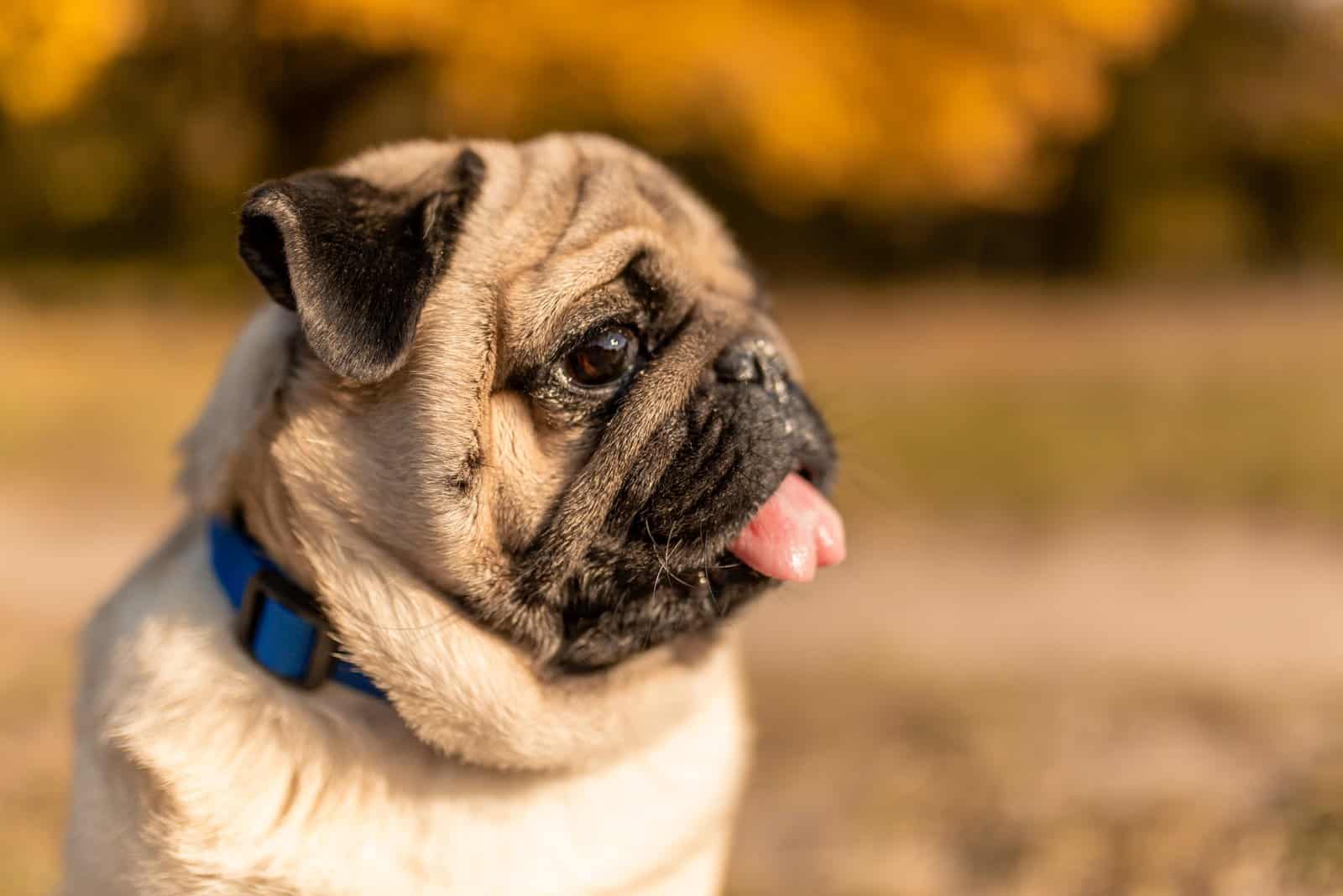
No matter the dog breed, canines can come in many coat colors. This is similar to hair color in humans – we have many different shades and textures, and while we’re not as colorful as dogs, you can still see people with various colors on their hair.
The same goes for Pugs. These adorable dogs come in several colors, such as fawn, black, silver, apricot, or even brindle!
However, not all dog colors are the same, and just because a specific color is accepted in one dog breed doesn’t mean it will be accepted in the other one. In fact, coat color can sometimes be the main feature you’ll use to differentiate two breeds.
For example, Pugs and Boston Terriers have a fairly similar appearance, but you won’t confuse the two with each other. This is because Boston Terriers come in a specific parti pattern that is rarely seen in Pugs.
I’ll list all the coat colors that Pugs can come in – but before we get to that, it’s important to note some rules and regulations kennel clubs have imposed upon Pug colors.
What Does The AKC Say?
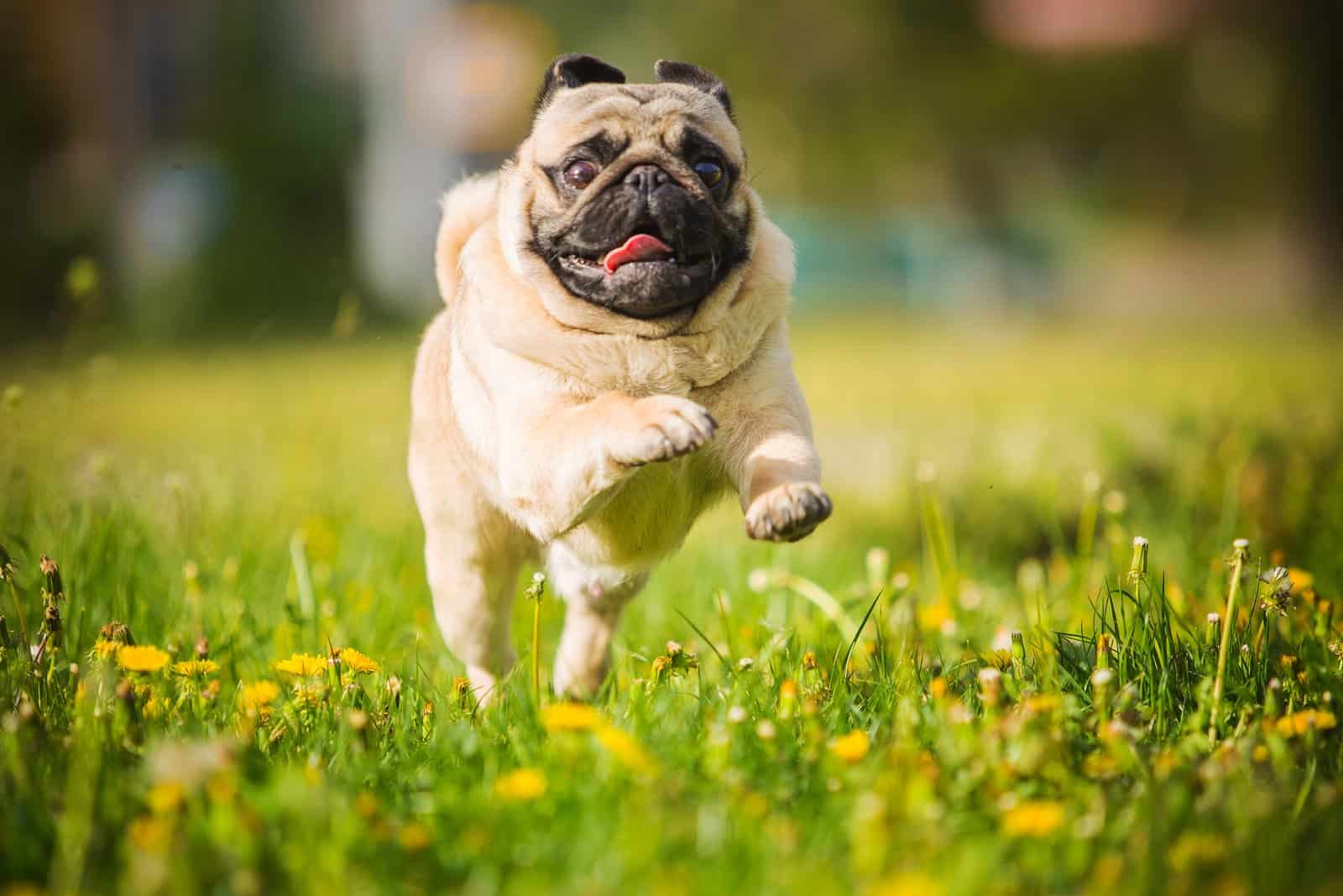
Kennel clubs are there to regulate the way a dog breed should look and behave, among other things. As such, they can also determine what coat colors are allowed within a certain breed.
But what does this mean for Pug colors?
Colors that fall within the breed standard are desirable, as they are the indication that the dog is purebred and healthy.
You can register dogs that come in standard colors with the kennel club, and this often means obtaining the breeding rights, as well.
According to the leading kennel club in the U.S., the American Kennel Club (AKC), the only two standard Pug colors are black and fawn.
All other coat colors are considered faulty.
The reason behind so few Pug colors is because the AKC is following the Pug Dog Club
What About Other Kennel Clubs?
Most kennel clubs agree on the basic features of the dog breed, which is why both Golden Retrievers in America and in Europe look like Golden Retrievers, despite having their own differences.
However, some differences between the breed standards do exist.
For example, the Canadian Kennel Club (CKC) allows three colors:
• Black.
• Fawn.
• Silver-fawn.
However, their understanding of the fawn color is pretty loose, so in a way they accept many colors other kennel clubs do not. For example, apricot and red dogs can be registered as fawn Pugs.
On the other hand, the Kennel Club of the UK (KC) and the Federation Cynologique Internationale (FCI) allow four Pug colors:
• Black.
• Fawn.
• Apricot.
• Silver.
As such, a dog that can’t be registered with the AKC might still be registered elsewhere. This is also why Apricot and Silver dogs are more common in Europe or Canada than in the U.S.
Standard Pug Colors
As mentioned, standard Pug colors are there as a proof that the dog is purebred or that he is healthy. Not just that, but they are a sign of a desirable dog that will do well in dog shows.
Standard Pug colors are much more common than non-standard ones. As such, most Pug puppies you’ll see listed for sale will come in these shades.
Here’s what they are:
Fawn
When you think of Pugs, chances are you’re thinking about them in fawn color. However, fawn is a fairly broad spectrum, as it might consider dogs in apricot or silver shade per request.
To make things easier, I’ll only list the classic fawn shade. Dogs I’ll describe in the Apricot or Silver color section can be registered with the AKC, but only if they are placed under the fawn label.
Fawn is a light, dull yellow shade. It can vary from light to medium, but it cannot be dark.
While you can find solid fawn colors, most fawn Pugs will have black ears and a black mask. This is perfectly fine, and these dogs can be registered.
Not just that, but it is also acceptable for a fawn Pug to come in several fawn shades – as long as these shades can be considered fawn. For example, you can have an apricot-fawn Pug with darker fawn shades that blend into the base coat.
Keep in mind that fawn can be a tricky color within the countries that follow the AKC standard.
As I’ve already mentioned, dogs of several shades might be considered fawn – however, this is as long as the color looks like fawn. In other words, genetics isn’t important, but rather what you can see.
This means that sometimes you and the person deciding on the registration application might not have the same idea of the fawn color.
In fact, AKC prefers to breed Pugs in a pure fawn shade, the one that doesn’t have any apricot or silver tones. However, if the tone isn’t too noticeable, you will be able to register your pup.
Black
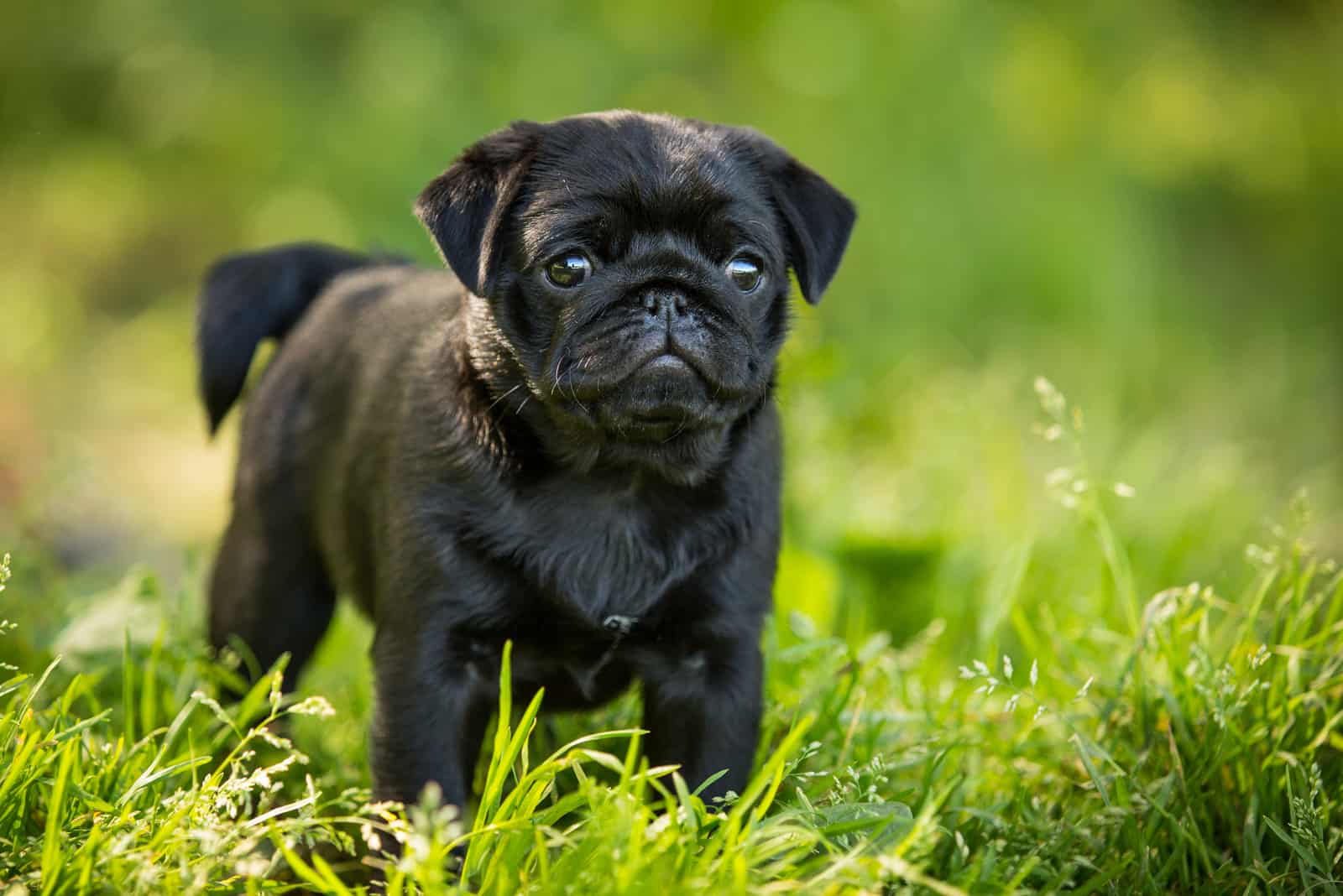
Black is the second standard coat color in Pugs, and it is probably the one you aren’t seeing that often. Still, black Pugs are treated the same way as the more common, fawn Pugs.
Most of the time, black Pugs come in a solid color. The color of their hair is rich and dark, and it is usually shinier compared to the fawn coat.
Tiny white markings are allowed within the breed standard, and they are usually located on the dog’s chest.
As your black Pug grows older, he’ll get plenty of gray hairs, or rather, these hairs will be more noticeable than on other hair colors. This is why it might seem as if black Pugs are becoming older faster than other coat colors.
Non-Standard Colors
Some Pugs come in colors that are considered non-standard by kennel clubs. This doesn’t necessarily mean that there is something wrong with the dog. However, there are a few things that need to be noted.
First off, Pugs that come in non-standard coat colors cannot participate in dog shows. This doesn’t mean much for people looking for pet quality dogs, but if you wanted to have a show dog, rare isn’t necessarily considered good.
Breeding dogs in non-standard colors is often frowned upon, and it might even be illegal in some municipalities. As such, you cannot get breeding rights.
Some of the non-standard and unrecognized coat colors aren’t naturally found in the dog breed. Their presence is an indication that the dog is a mixed breed.
Finally, some coat colors can also mean that the dog has some incurable genetic health problems.
Such is the case with albino or merle dogs, but I’ll talk about them later on.
Also, there have been some indications that dilution genes can lead to an increased chance of many health conditions. For example, chocolate dogs have an increased chance of many health conditions.
With all that out of the way, here are non-standard Pug colors:
Apricot
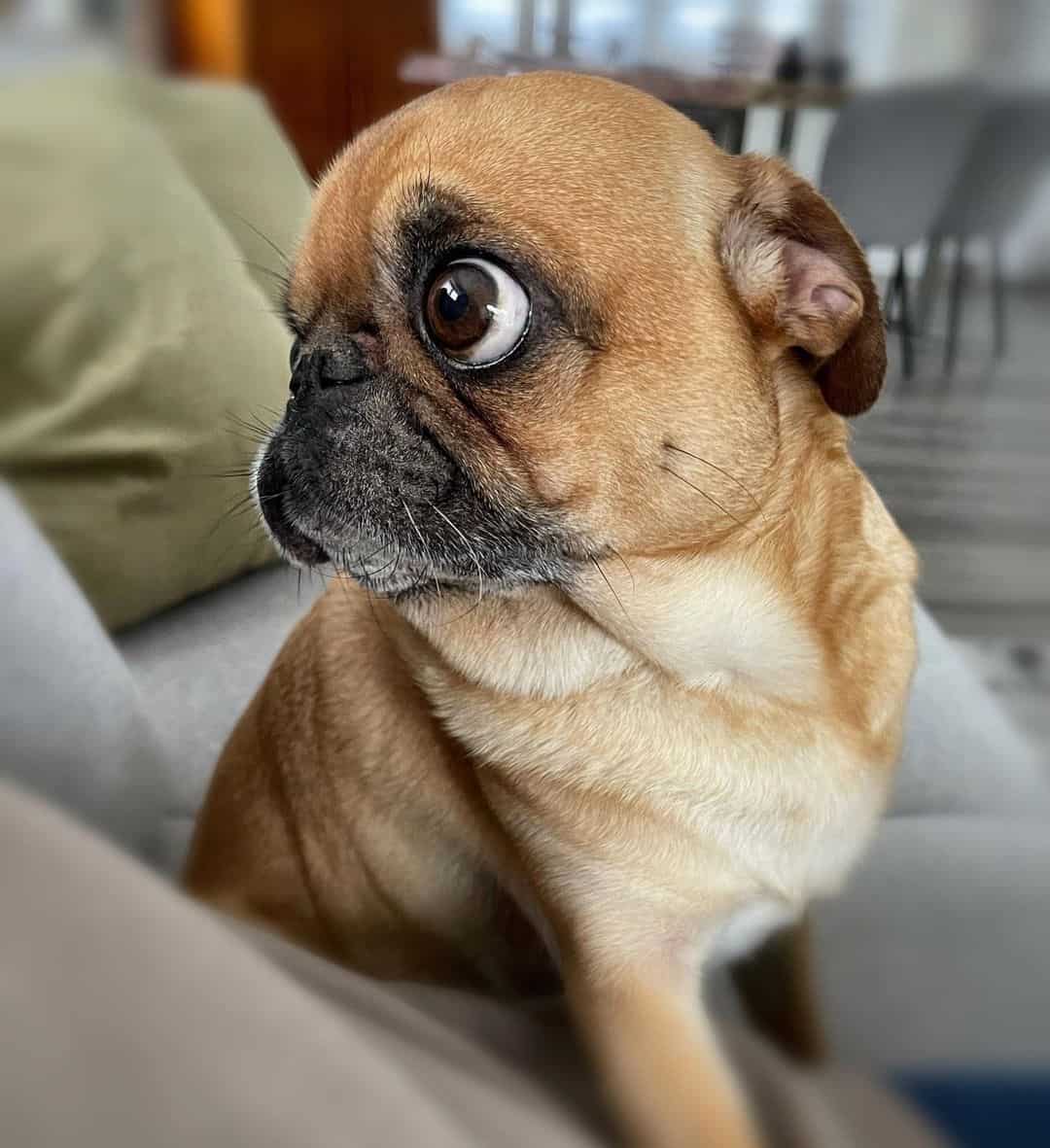
Photo from: @lennonandbutch
Apricot, or apricot fawn pups, come with a warm, orange undertone. This color isn’t the same as apricot in some other dog breeds – for example, Boxers. Instead, it is similar to the apricot color in Chihuahuas.
Apricot Pugs rarely come in a solid color. Instead, they often have fawn or white patches, usually on their chest. They also have a black mask.
In the U.S., most apricot Pugs are registered as fawn, unless when they have such bright colors there is no way they could be mistaken for any other color other than apricot.
Silver
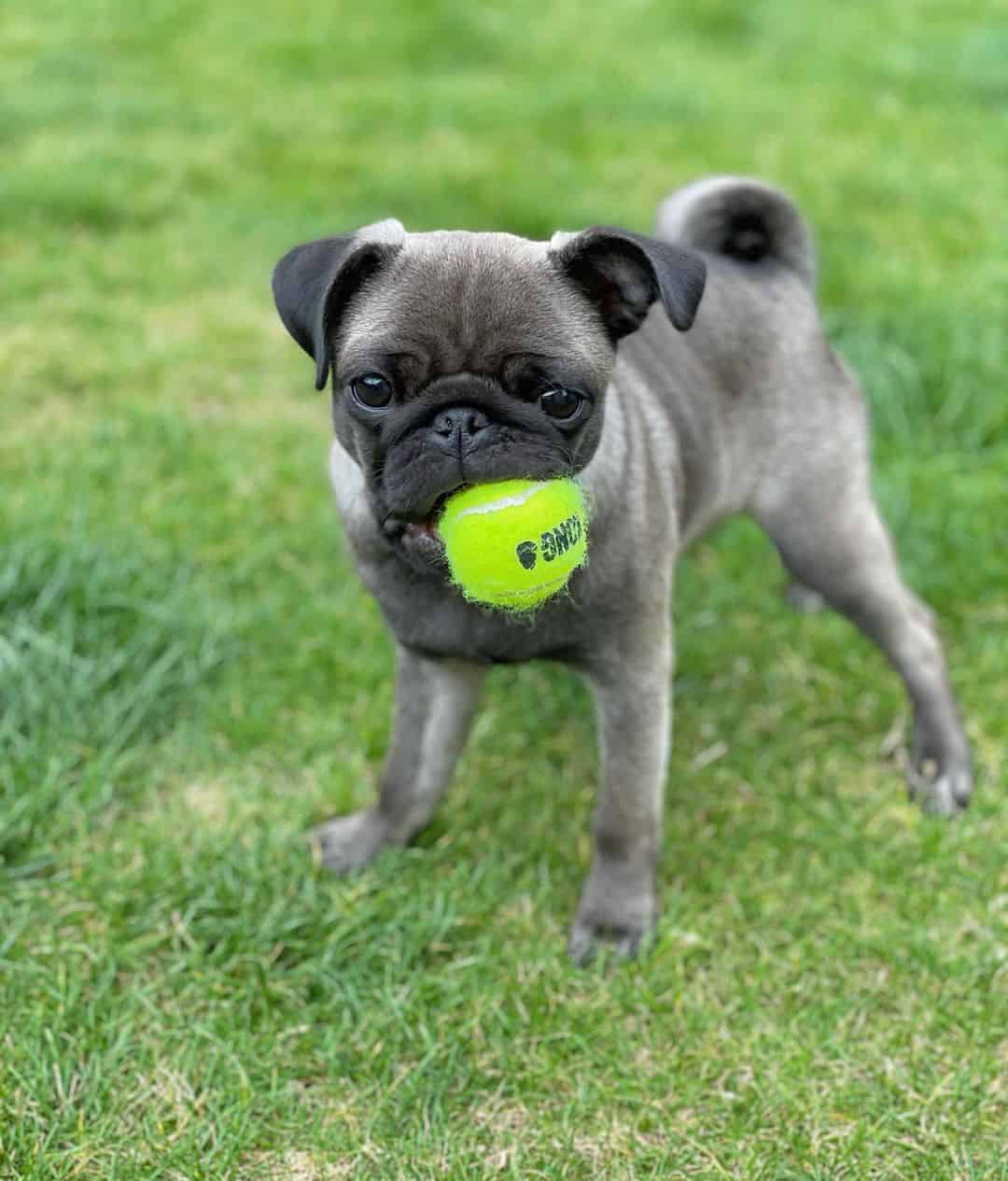
Photo from: @elsie.pug
Silver Pugs are sometimes also known as silver fawn Pugs, as some might be registered as the fawn color if the owner requests it.
This is the lightest Pug color out there. It is also fairly rare, and there are not many silver Pugs in the U.S.
These dogs come in a light gray coat. The shade isn’t the same blue color, and it isn’t caused by a blue dilution gene, as is the case with silver or gray dogs of many other dog breeds.
As such, these pups will often come with a black mask and black ears.
Brindle
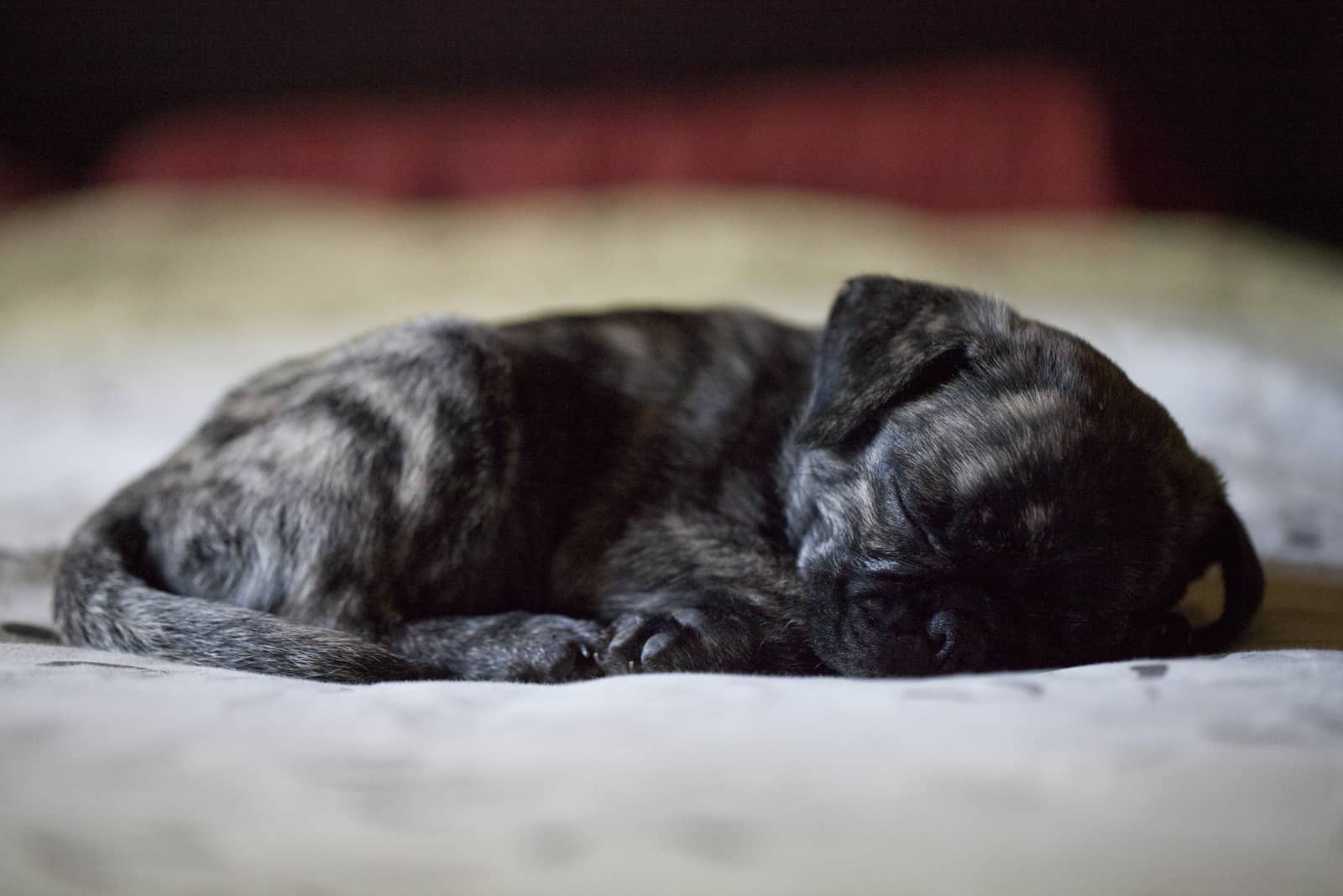
While brindle is considered a coat color, it is, in fact, a pattern of alternate colors. Brindle pugs have interlocking dark and light colors, giving them tiger-like stripes. This is a common coat color in some dogs, such as the American Bulldog or the Bull Terrier.
Brindle is very rare in Pugs. In fact, some people wonder whether purebred Pugs even exist, or if they are crossbred. While this is an ongoing debate, the science seems to point towards the fact that yes, purebred brindle Pugs are a real thing.
Brindle doesn’t exist in modern Pug’s bloodlines. This is why you won’t see Pugs from recognized bloodlines come in this coat color. This isn’t a desirable color and reputable breeders won’t keep on producing brindle dogs.
As brindle is the dominant coat color – more on this later on – there is no chance for it to suddenly appear within a bloodline. This is why there are so few brindle Pugs.
However, there are many indications that brindle was a common Pug color centuries ago, back when the breed was initially created. This is challenging to know as the records about Pugs were destroyed.
However, some of the first recorded paintings of the breed show Pugs in brindle color.
As such, brindle was probably a standard color many generations ago.
As the only way to get a brindle Pug is to breed a brindle parent – something that isn’t considered a good breeding practice – it’s easy to see why this color is almost entirely removed from the breed.
Chocolate
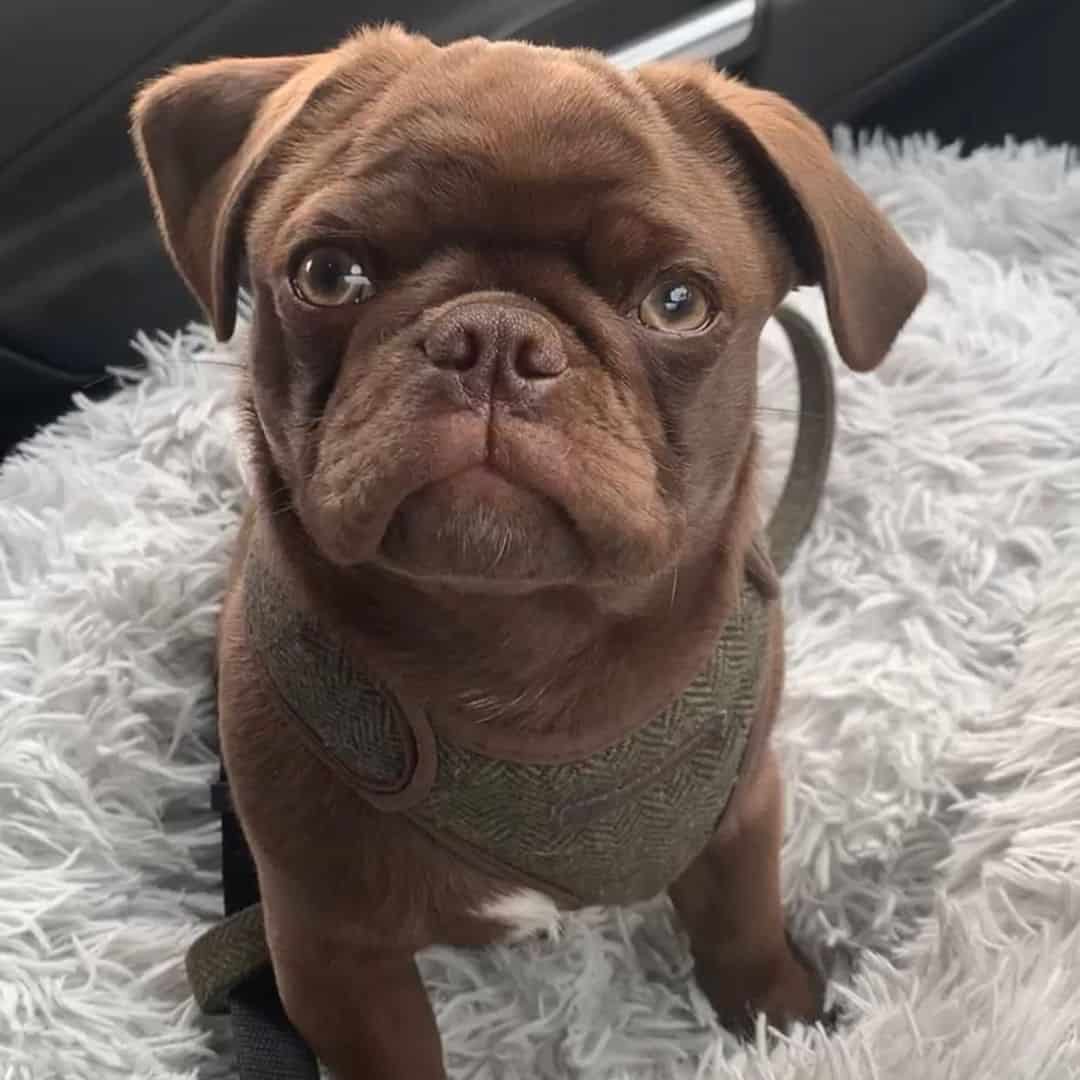
Photo from: @junior_the_chocolate_pug
Chocolate Pug color is, in fact, the diluted black coat color. It is caused by a recessive liver dilution gene that affects eumelanin, the pigment that is responsible for black color in dogs.
Chocolate Pugs not only have brown coats, they also have brown noses, lips, and paw pads. This is because the gene affects not just the hair, but every type of pigment in dogs.
Chocolate-colored Pugs don’t have a black mask, as no strands of black pigment can exist on these dogs. In fact, they are often solid-colored.
However, they can have smuttiness, although it won’t consist of black hairs but rather of dark brown ones
Black And Tan
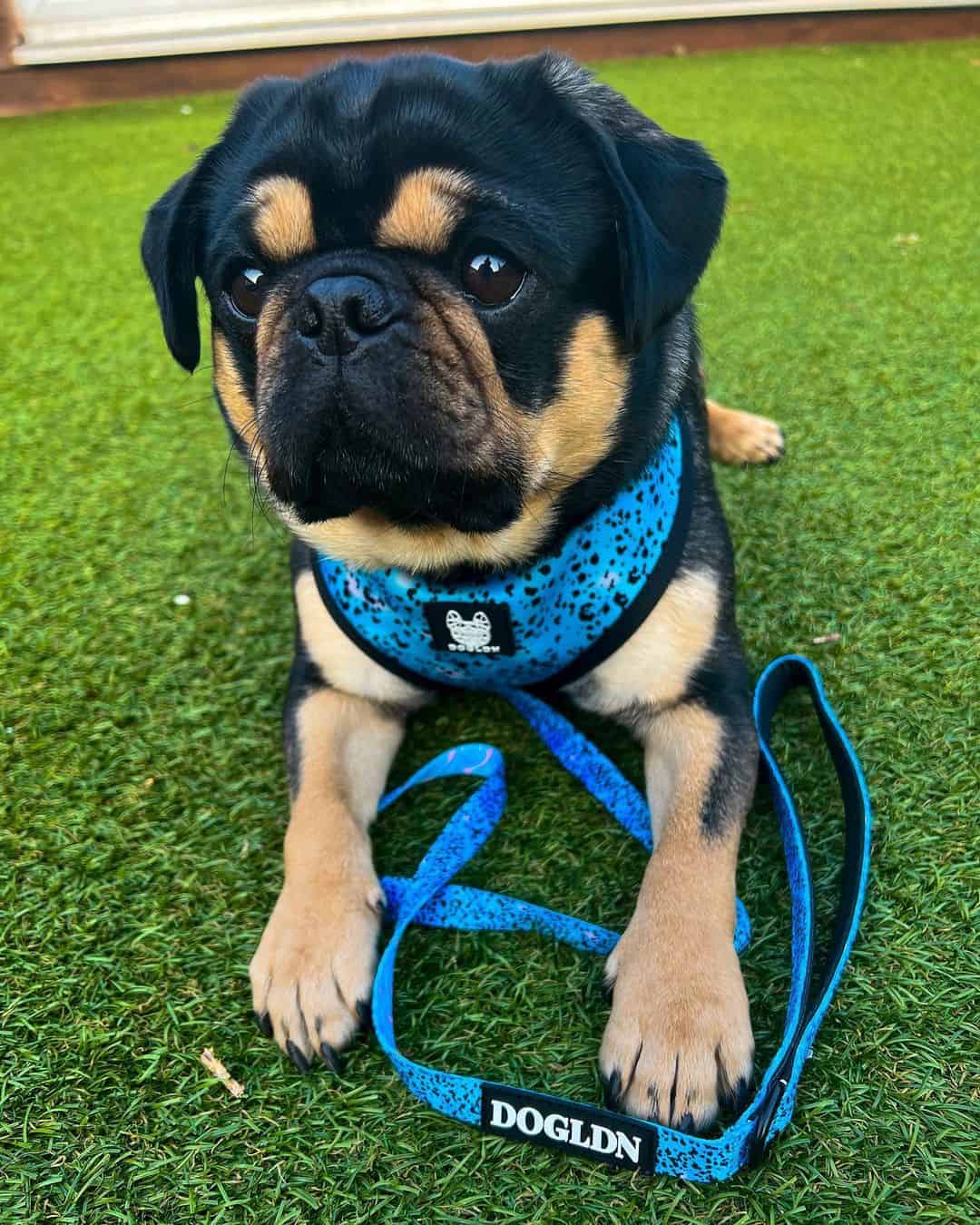
Photo from: perry_thepug_
Black and tan Pugs are extremely rare. They are the result of crossbreeding black Pugs with some other dog breed, such as a French Bulldog.
The tan is a dull reddish-yellow color that is common in many breeds, but not in Pugs. It looks a bit like a dark shade of fawn, but if a Pug was to come in such a dark color, he likely wouldn’t be registered with the AKC.
Black and tan Pugs have a black base coat with tan markings located on the dog’s chest, tail, legs, ears, and head. They can sometimes even come on the dog’s muzzle, but this is very rare.
Smuttiness is common with this coat color, as a large portion of the tan color can have a black overlay. Of course, this pattern won’t be noticed on the black parts of the dog’s coat.
As you’ve probably guessed, this is a faulty color. No dog in this coat color will be able to be registered or to participate in any dog show.
Black And Cream
Black and cream is a common color combination in many dog breeds, but not in Pugs. Quite the opposite – it’s rather rare.
Many people might confuse these pups with standard fawn pups, but there are a few differences between the two.
Cream is a light yellow color that, on its own, might be registered as fawn – at least in the case of Pugs’ breed standard.
However, these are, in fact, black Pugs with cream markings. Some might look like reverse-colored Pugs, as the cream markings are usually distributed on the dog’s chest, face, ears, legs, and neck.
Just like a few other Pug colors from this list, this isn’t a color that’s naturally found in the breed. All black and cream Pugs are crossbred, as this is how the genes were introduced to the breed.
Panda
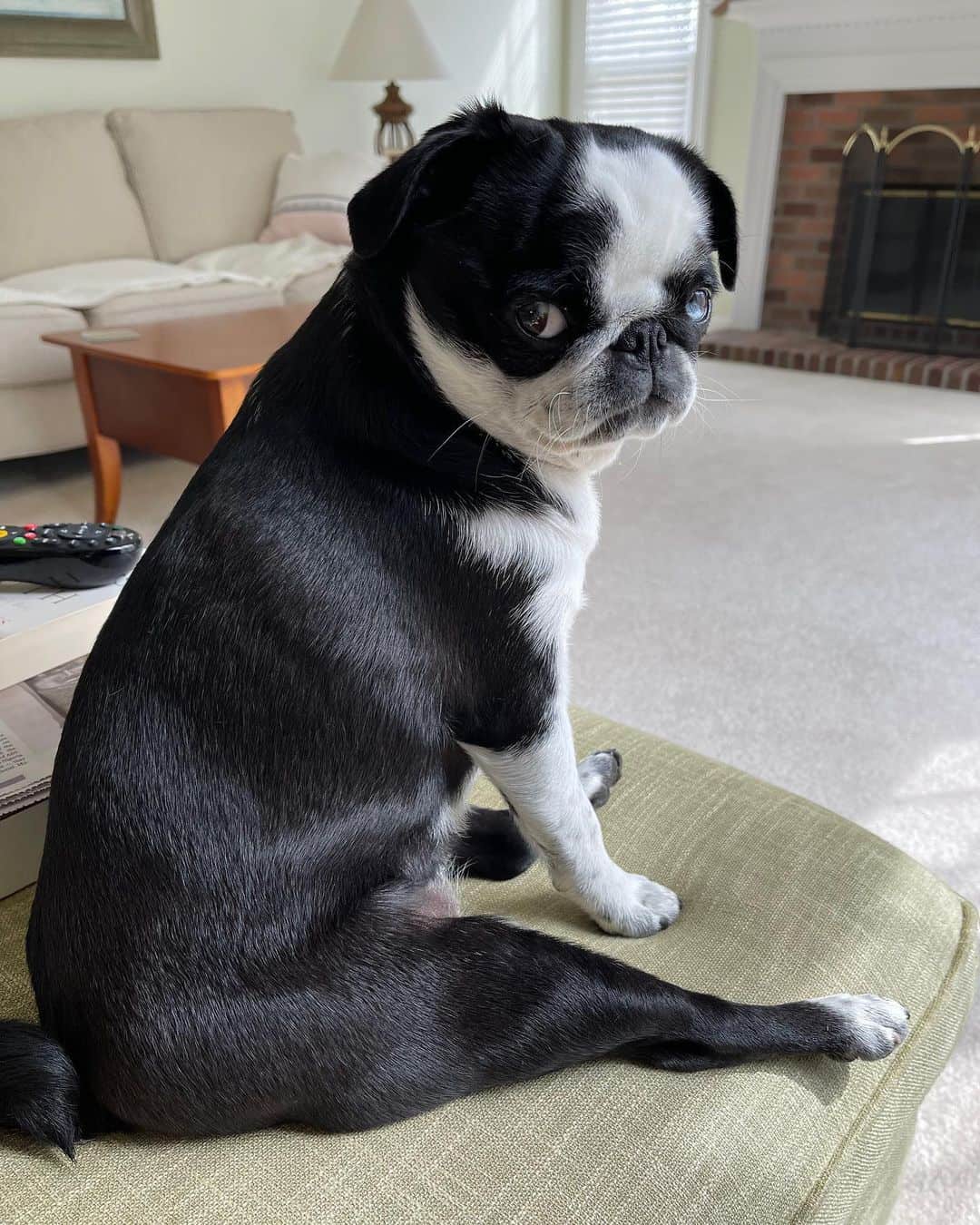
Photo from: @poppy_the_panda_pug
Panda pugs are some of the rarest Pug colors out there. Also, this is another Pug color that isn’t naturally found in the Pug breed, which is why these dogs are considered a mixed breed.
Panda Pugs are black and white dogs with parti markings. However, as they often have the remnants of the black mask around their eyes, they will look like Pandas.
Some Pugs suffering from vitiligo might also have this appearance.
Merle

Merle is a highly undesirable Pug color. In fact, its existence is an indication that a Pug has been crossbred. This isn’t a color naturally found in Pugs, which means that any merle Pug could barely be considered a pug.
Many merle Pugs are, in fact, English Bulldog mixes, as Bullies are known for coming in many coat colors.
Merle is indicated by the presence of three colors randomly splattered over the dog’s body. This includes the white color, the darkest, base color, and the diluted version of the base color, which would usually be blue.
While beautiful, merle is a color that is extremely frowned upon. No reputable breeder will ever breed merle Pugs.
This is because the merle gene is connected with a huge number of health issues, some of which can severely impact your dog’s quality of life.
The issue isn’t with dogs with merle patterns, as they will inherit only one copy of the merle gene. However, when a Pug puppy inherits the merle gene from both parents, he becomes what is known as a double merle.
Double merles don’t have a distinguishable pattern but come in pure white color. They often have eyes of different colors (heterochromia) or bright blue eyes.
More importantly, they are extremely prone to blindness, deafness, cardiac issues, and bone problems. In fact, more than 70% of double merles will have some genetic health condition.
Because of this, the intentional breeding of merle dogs is forbidden by many kennel clubs.
White
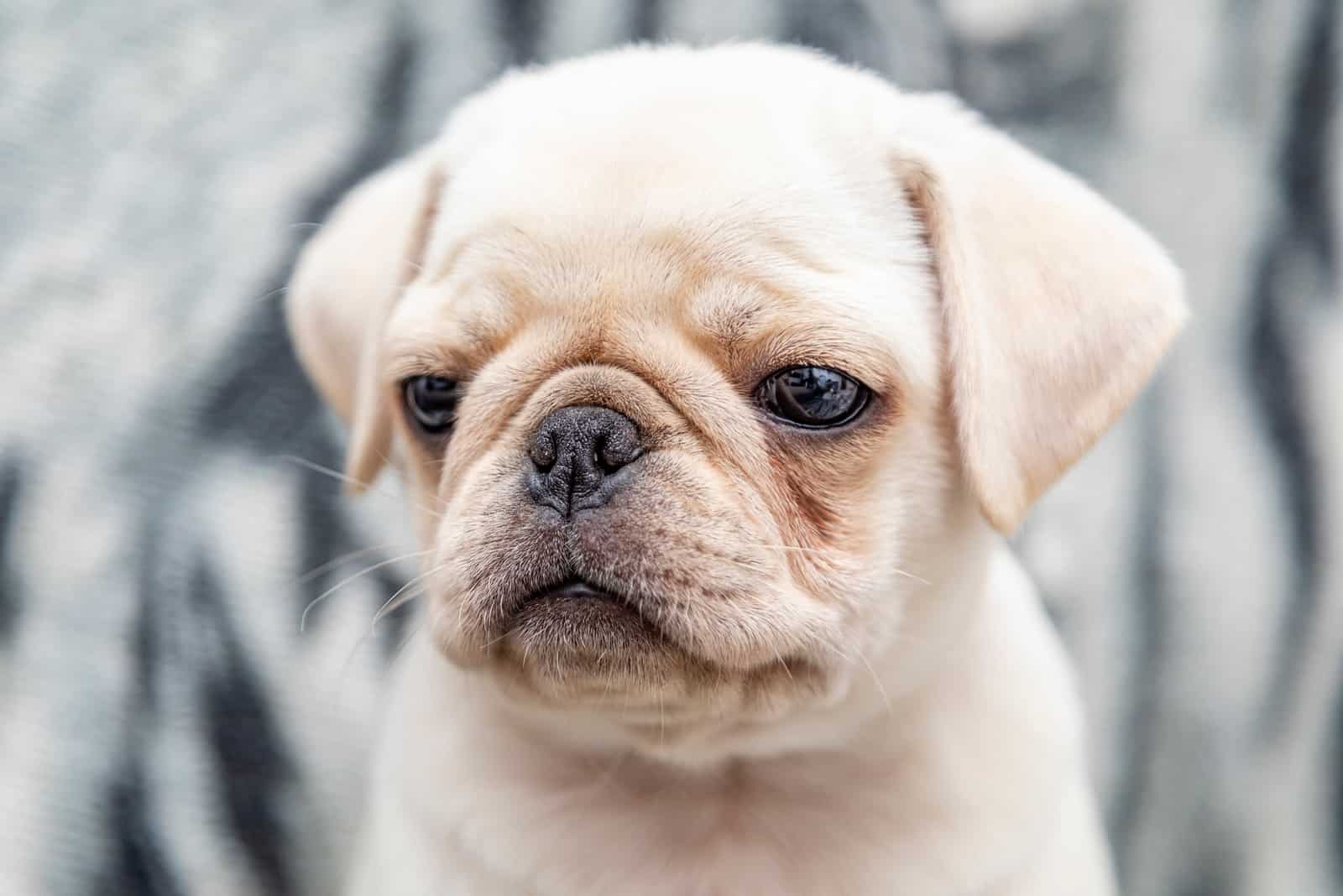
White is another color that isn’t naturally found in Pug bloodlines. Seeing a pure white Pug likely means that the dog is crossbred, or even worse, that he is a double merle.
The white coat color also occurs with certain diseases, such as vitiligo or albino. Vitiligo dogs have patches of white coat color that will increase over time, making them resemble a Panda. They will rarely be pure white, and if they do, they become white over time.
Albino Pugs have a solid white coat. This is because they don’t have any pigment in their bodies. Another consequence of this might be red eyes.
Unfortunately, albinism is also connected with many other health problems. The lack of proper coat color is only the tip of the iceberg. This is why they are not intentionally bred, but dogs with albinism might appear randomly within the bloodline.
Pug Coat Patterns
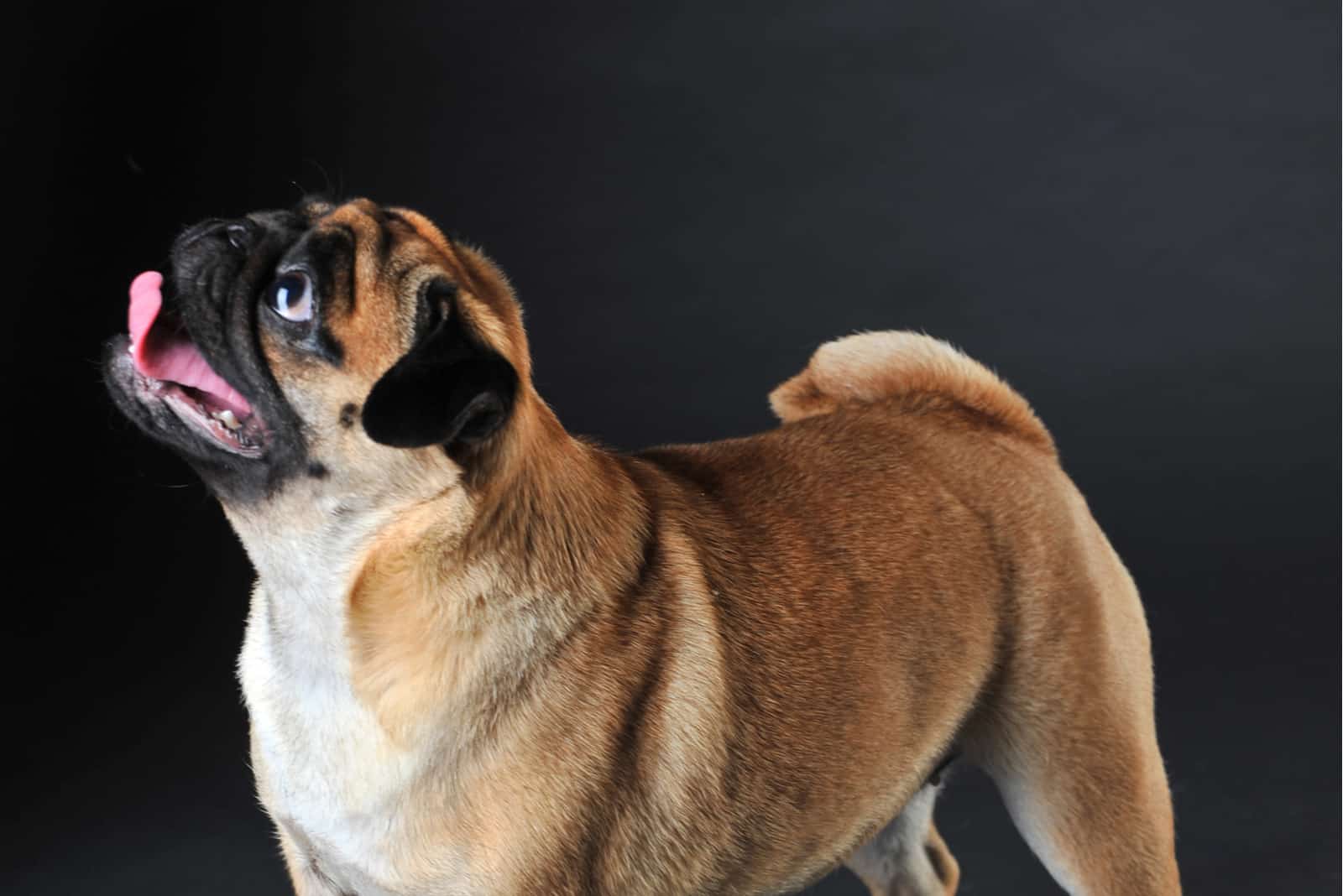
Next to coat color, there are many patterns that this breed should or shouldn’t have. While the AKC doesn’t officially mention them, they are included in the description of the breed standard, which is how you can conclude which ones are desirable.
Not just that, but the Pug Dog Club of America mentions many of these patterns, which is another way in which you can determine whether your pooch could be successful in the show ring, or if he should be a family dog only.
Below are some of the commonly found coat patterns in the Pug breed:
Smuttiness
Smuttiness is very common in lighter colors of Pugs. This is when a dog has scatterings of black hairs over the base color, but the hairs are so few in numbers and distributed in such a way that the dog doesn’t have patterns. Instead, it might give your pooch a dusty appearance or make his color challenging to determine.
Smuttiness gives the dog a similar appearance as sable, but once you look closely, you’ll see that the two are very different.
While smuttiness is a black overlay, sable is when the dog has black hair tips. As such, a dog with smuttiness has two different coat colors on his body. A sable dog has two colors on a single strand of hair.
Smuttiness is very noticeable in light Pug colors, especially when you compare it to darker colors, such as the deep apricot.
This pattern doesn’t have to be spread equally all over the dog’s body. In fact, it shouldn’t be. Smuttiness is very desirable on some body parts, while it can be frowned upon on others.
For example, it is very desirable to see a Pug with smuttiness on the center of the dog’s back or on the forehead.
On the other hand, strong smuttiness can also be very undesirable, especially if located on the legs, flanks, head, and saddle. It won’t disqualify your Pug, but it is a fault, and such a dog won’t do well at conformation shows.
The Thumbprint
The thumbprint is a spot of smuttiness on the dog’s forehead. It is also known as the diamond or the thumb mark – but it doesn’t have to be diamond-shaped. All non-black Pugs can have it.
This is yet another desirable pattern in Pugs, although it isn’t a necessity for the breed standard.
The thumbprint might sometimes be challenging to notice, as the Pug’s forehead is wrinkled. In fact, some Pug owners think that their dog has a thumb mark, but it’s the wrinkles casting the shade.
Most of the time, the thumbprint will be noticeable on newborn Pugs. It is very rare for a puppy to develop this pattern as he grows older. However, the existing thumbprint might change his shape and size.
The Trace
The trace is when the smuttiness is distributed in such a way that it leaves the dog looking as if there is a dark mark going down his back. It can be found on all non-black Pugs.
The trace can start on the back or higher up on the dog’s neck; both are considered desirable. From there, it will go all the way to the base of the tail, running in a straight line. How dense or thick the trace will be can vary.
This is a very desirable marking on Pugs, although not all Pugs will have it. However, most dogs purchased from reputable Pug breeders will have a more or less visible trace on them.
Also, judges in the show ring seem to love thick, visible traces, and dogs that have it usually achieve better results.
The trace might appear on the day the puppy is born, just to fade away over time. Similarly, a Pug might be born without the trace and develop it as he grows older.
As such, it’s important to wait until your Pug puppy grows before you can determine whether he has it or not.
Black Mask
Mask is a necessity on all non-black Pugs. All Pugs have to have a black mask, no matter their coat color.
The shape of the mask and how much of the Pug’s face it covers might vary. In general, it will start under the dog’s chin, go over his muzzle, and around his eyes.
Some Pugs might have an area of base coat color between the black around their eyes and on their muzzle. Others will have black color all over their faces.
Not just that, but the mask doesn’t have to be solid black. It isn’t uncommon for a Pug to have some fawn or silver hairs on the black, and this won’t cause disqualifications in the show ring, although it isn’t considered as pretty as clear black masks.
While the mask might become darker as the dog reaches his senior years, it will always be present from birth.
Black Ears
Next to the black mask, all Pugs should have black ears.
When a Pug puppy is born, he’ll appear to have smuttiness on his ears. Over time, though, this will darken, but just how dark it will become depends on the individual puppy.
Some pugs will have black ears that are the color of their masks. Others will have very dark ears with strands of lighter-colored hair.
Also, how much of the dog’s ears will be dark can slightly vary – as long as the ears are black from the crease down.
Just like with the mask, the darker the ears – the more desirable your Pug is.
Mittens
Mittens is a common term for felines, but it’s rarely used for dogs, which is why you might be surprised that I’m mentioning it now.
Mittens, or white paws, are a very rare Pug color pattern. It implies that your Pug has white markings on his paws in such a shape that he looks as if he is wearing mittens.
A Pug with white paws is considered faulty and he’ll be automatically disqualified from the show ring. Not just that, but such a dog cannot be registered.
Still, it is possible to have a Pug with such a pattern. Most of the time, mittens will appear on Pugs with white markings, as the same gene is causing these coat variations.
Pug Eye Color
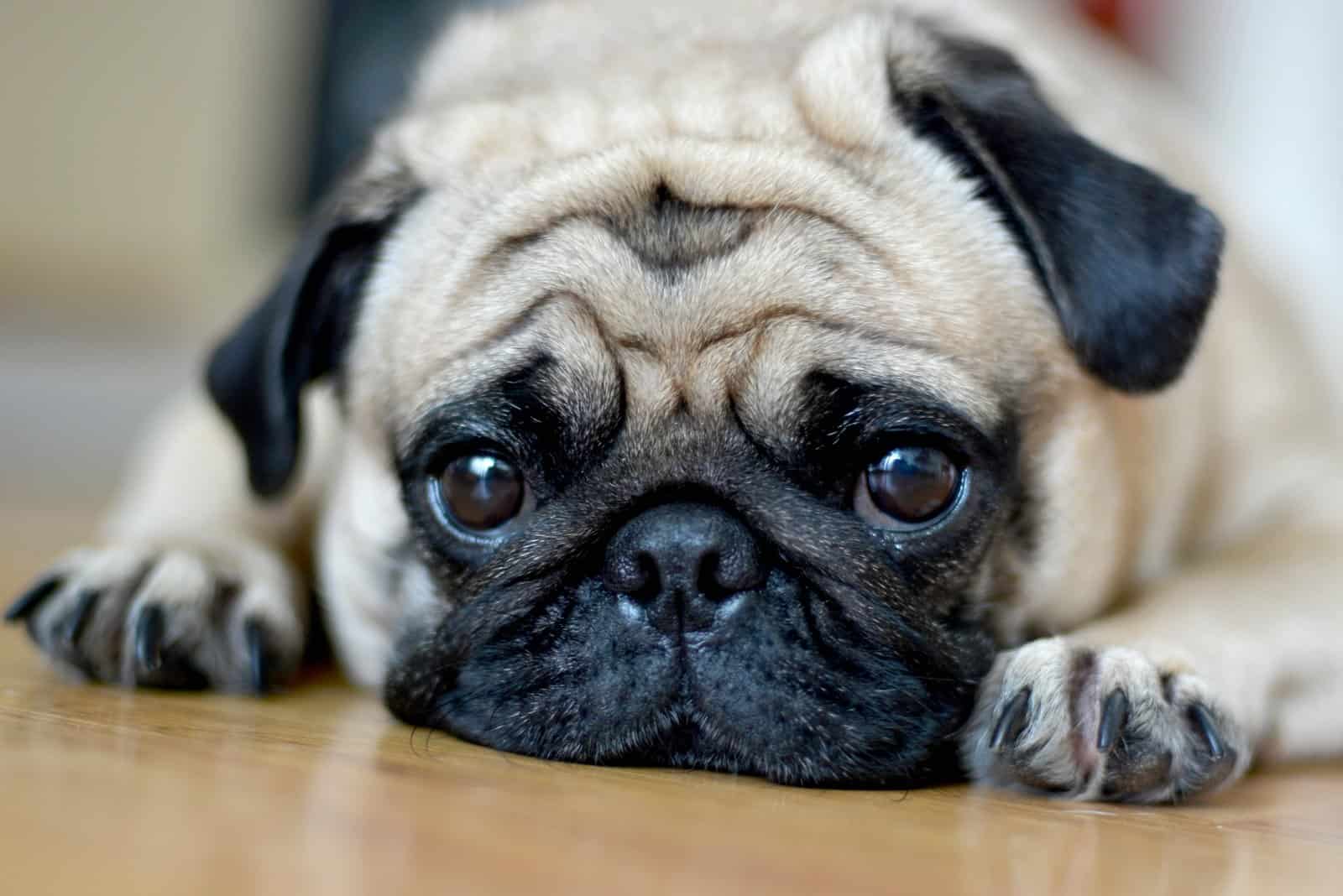
While there are a few Pug coat colors, when it comes to the color of your dog’s eyes, there isn’t much variation.
Purebred Pugs will have brown eyes, without exception. The exact shade can vary from medium brown to almost a black color, but it can never be lighter.
Of course, just like with most mammals, a newborn Pug will have dark blue eyes. This is because the melanin levels are not yet high enough for the dark color to form.
By the time your cute Pug puppy is six to seven weeks old, his eye color should darken.
It’s important to note that, according to most kennel clubs, the Pug’s eye color is simply described as ‘dark’.
Albino or merle Pugs might have blue eyes or even red eyes, but this is entirely unacceptable according to the breed standard. Of course, as both colors are unacceptable, this alone doesn’t make much difference.
Pug Color Genetics
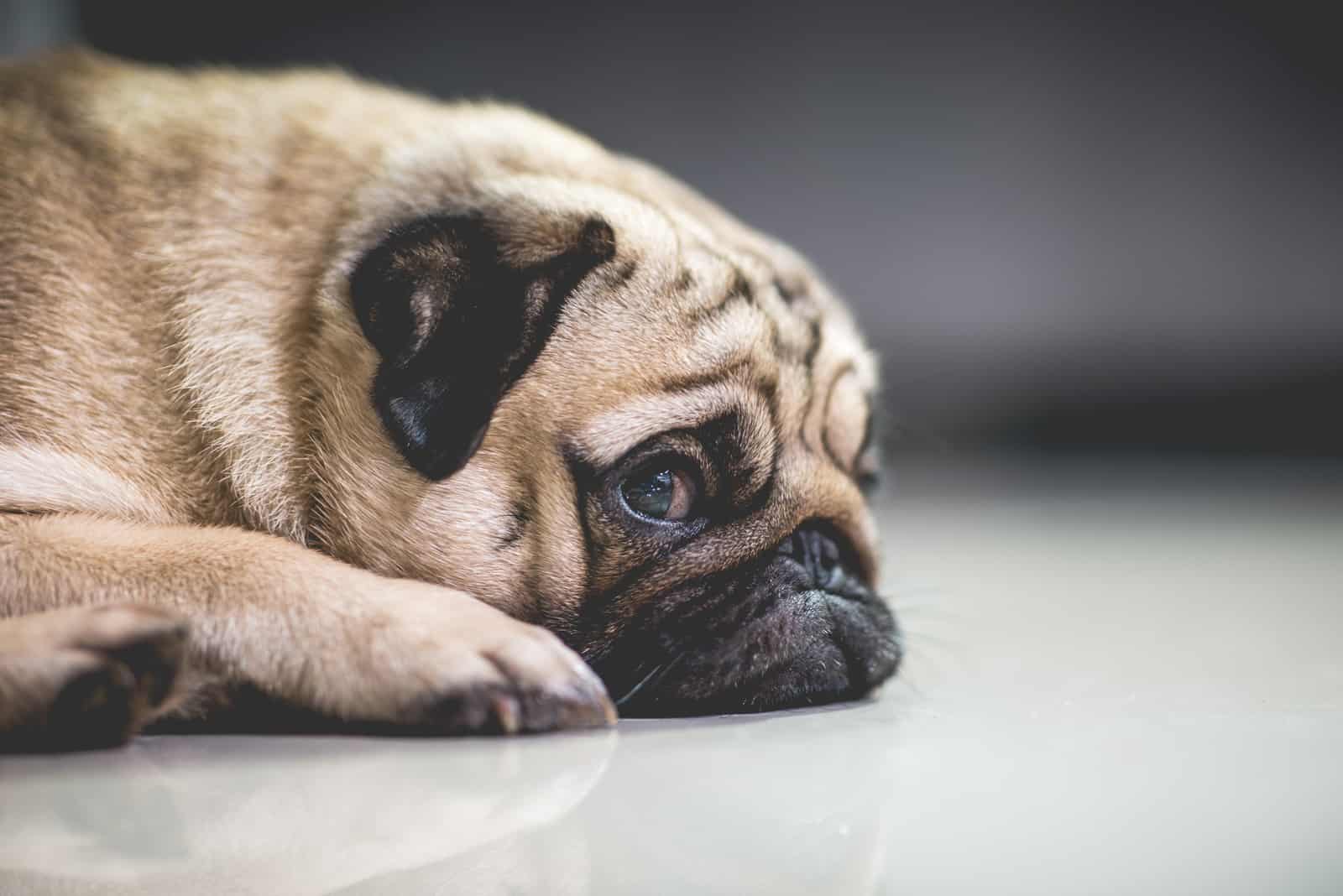
Pug’s coat color, just like everything else on him, is caused by genetics.
Every dog inherits genes from his parents. This also includes the genes that cause coat colors. However, things aren’t as simple as they might seem at the first glance.
First off, all genes are either dominant or recessive. In the case of pugs, the black gene is the dominant one, while the fawn one is recessive.
If we follow common sense, this means that if you breed a black and a fawn Pug, you’ll get a black Pug.
However, the black Pug might secretly be carrying the recessive fawn gene, which means that many puppies from the litter might be fawn.
This is what makes breeding dogs of a specific coat color rather tricky.
In fact, you’ll probably have more luck getting recessive Pug colors. All you need to do is to breed two fawn Pugs to get another fawn Pug.
This is because the dominant black gene cannot be hidden.
What makes things confusing are the genes that determine the markings on your Pug dogs.
There are many pattern genes, and they affect the distribution of the coat color. These genes work together with the color genes, so you can get adorable Pugs in various colors and shades.
Most white markings on Pugs are caused by the parti gene. This is the same type of gene that leads to many dogs being bicolored.
For example, the parti gene in Pugs can cause white markings on the dog’s chest, markings on their forehead, and even mittens!
Not just that, but you also have dilution genes – although these aren’t present in Pugs naturally, so I won’t explain them too much.
Dilution genes affect the existing coat color, causing it to appear lighter than it normally would. At the same time, this gene can give your doggie an entirely different coat color!
As you can see, the Pug’s color is determined by many factors, and just a single wrong gene can make your pooch look very different from his parents or siblings.
One of the examples of a dilution gene at work are the chocolate Pugs, which are the product of liver dilution.
What Is The Rarest Pug Coat Color?

Many dog lovers would like to have a dog that’s like no other. This can make them wonder what is the rarest Pug color, and which color is the most common one.
Research has shown that about two thirds (65%) of Pugs come in a fawn color, or in a color that falls within the fawn range. This means that fawn is the most common Pug color.
About 22% of Pugs come in black color, making this the second most common coat color.
As for the non-standard coat colors, the percentage goes as follows:
• 4% of Pugs come in apricot color.
• 3% come in silver-fawn.
• 1% are brindle dogs.
The remaining 4% include dogs with more specific descriptions, such as ‘fawn with sable’ or ‘white markings’.
As such, it’s challenging to determine which color is the rarest one, as there are several color combinations that make this a tough decision.
However, out of coat colors that could be categorized, brindle seems to be the rarest one.
Pug Color Change
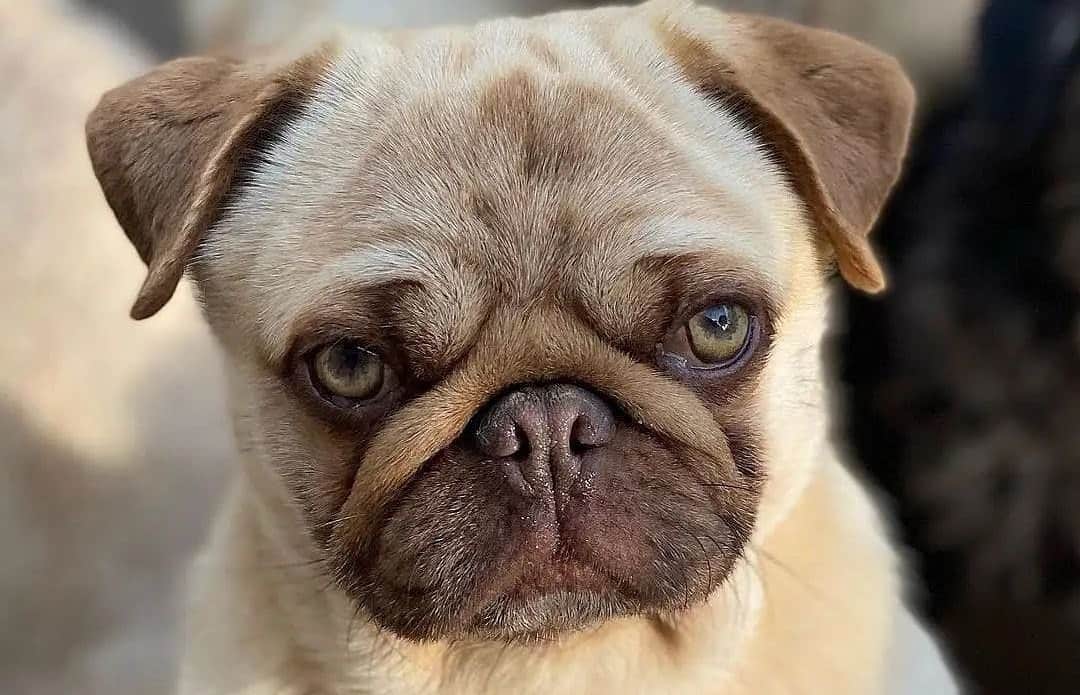
Photo from: @pugs_of_day
Pugs are known for changing their coat color as they grow older. Of course, this color change shouldn’t be severe. A black Pug puppy won’t grow up to be a fawn adult dog or vice versa. However, they’ll probably experience some color change.
For example, during the first year of their life, fawn Pugs might become lighter or darker in shade.
Not just that, but many young Pugs will express smuttiness which will reduce as they grow older – or even disappear entirely!
Not just that, but many times the dog’s mask might be barely noticeable in a newborn Pug puppy, but it will become entirely black as the dog grows older.
The coat color change in Pugs can also cause some issues when registering dogs. It isn’t unheard of that a puppy that was registered as fawn became an apricot adult.
Black Pugs can start graying as they grow old, so you might also notice white hairs appearing around their muzzle and on their face when they are seven or eight years old. The number of gray hairs will likely increase over time.
Gray hairs will be present on non-black Pugs, as well. However, they will be barely noticeable, and the dog won’t appear to have experienced any change of color.
Do Pug Colors Matter?
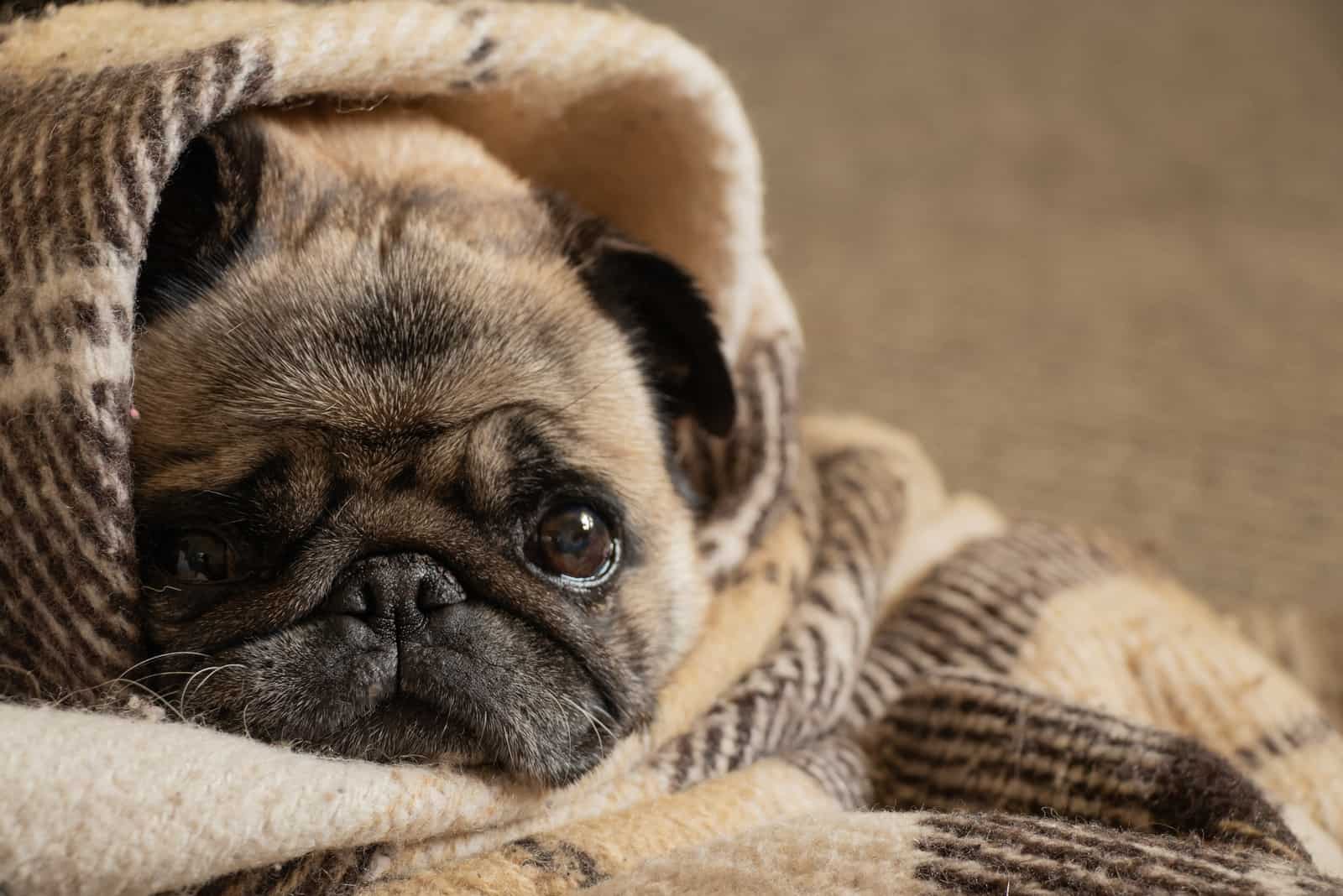
The dog’s appearance is very important – if you plan on enrolling your dog in a show. For any other purpose, all Pugs are equally good pets, no matter their coat color.
There is no indication that the Pug color will affect your dog’s behavior in any shape or form. All Pugs were bred to be family companions, regardless of their color. This means that not only are there not any genetic reasons for the change in temperament to exist, but also there are no historical ones.
Pug colors determine just that – the coat color of your dog. Everything else is up to how you train and socialize your little pup.
Still, it’s important to buy from reputable breeders and to avoid the faulty colors – the ones not found naturally in the dog’s bloodline.
These colors might be an indication that the puppy you’re looking at is sick or crossbred.
While there is nothing wrong with mutts, if you’re going to pay money for your new pup, you should know what you’re getting. When you buy a dog that comes in a ‘unique color’, you might be buying a mixed breed dog with some genetic disorder you are not aware of.
With that being said, if you prefer one coat color over the other – feel free to go and find a dog that looks the way you want him to!
Read Next: 225 Pug Names All Better Than Doug















